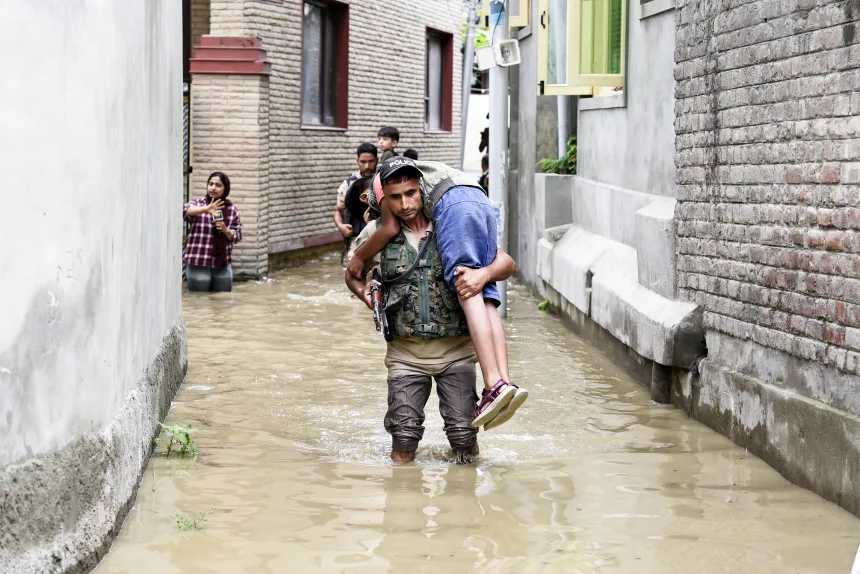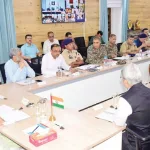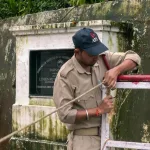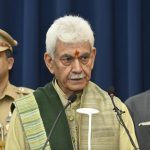Srinagar, Aug 27: Jammu and Kashmir witnessed one of the heaviest rainfall spells in decades, with some areas recording nearly 300 mm of rain in just 24 hours, triggering flash floods, landslides, and widespread disruption. However, officials said Wednesday evening that the immediate flood threat has eased as water levels began to recede.
In Jammu, the rainfall broke a 115-year-old record. The region received 380 mm in just 24 hours, the highest since 1910 when the observatory was set up.
The previous record was 270.4 mm on 25 September 1988, and before that, 218.4 mm in August 1996.
Udhampur witnessed an unprecedented 629.4 mm in a single day, surpassing its previous record of 342 mm (2019).
Reasi, Doda, and other districts recorded 250–300 mm, while parts of South Kashmir saw 85–86 mm and Pahalgam about 55 mm. Central and North Kashmir experienced relatively moderate precipitation.
“Though water levels are stabilising, residents in low-lying areas must remain vigilant,” said Dr Mukhtar Ahmad, Director, Meteorological Department. He added that intermittent light rainfall may continue till early September, particularly in the Chenab Valley.
Srinagar Police deployed teams across flood-prone zones for traffic regulation, dewatering, and emergency response. Helpline numbers were circulated for residents in distress.
Police urged citizens to avoid unnecessary travel and report fallen trees or waterlogging. “The public must adhere to advisories to ensure safety,” said a police spokesperson.
“This has been an extraordinary weather event, but fortunately, the intensity has reduced and levels are declining,” the Director said.
While authorities confirmed that the flood threat has eased with receding water levels, the situation remains fragile. Intermittent rainfall is expected until September 6–7, though its intensity will likely stay low.
Dr Mukhtar urged residents not to lower their guard. “Though the danger of a major flood has been removed, people in low-lying and vulnerable areas must remain cautious,” he said.
As of 11:00 pm on Wednesday, the Disaster Management Department reported receding gauges at key locations: Sangam at 22.63 ft, Ram Munshi Bagh at 21.09 ft, Asham at 12.22 ft, Pampore at 6.06 m, and Khudwani at 7.12 m (below the 8.50 m danger mark).
The Srinagar–Jammu National Highway (NH-44), Jammu–Pathankot Highway, Kishtwar–Sinthan Road (NH-244), and Mughal Road have all been closed due to landslides and shooting stones. The Srinagar–Leh Highway was briefly blocked due to snowfall at Khardung La and Zanskar but later cleared by the BRO and Traffic Police.
Train services were suspended, with 18 trains cancelled and four short-terminated.
In Jammu division, more than 5,000 people were evacuated as rivers swelled and homes were inundated. The Tawi River crossed the evacuation mark, prompting closure of bridges and triggering rescue operations by Army, NDRF, SDRF, and local police.
Essential services bore the brunt of the storm. Power, water supply, and internet connectivity were badly hit across several districts.
Educational institutions were shut, and the J&K Board of School Education postponed Class 10 and 11 examinations scheduled for Wednesday.
Rivers in the Jammu division swelled dangerously. The Tawi river crossed the evacuation level in Jammu and Udhampur, forcing the closure of the Tawi bridge. Other major rivers – the Basantar in Samba, Ujh in Kathua, and Chenab in Doda, Ramban, and Akhnoor – also crossed danger levels.
The Jammu–Pathankot highway was cut off after a bridge collapsed, while the Jammu–Srinagar National Highway was blocked by shooting stones. Railway traffic also came to a halt, with 18 trains cancelled and four others short-terminated.
Meanwhile, in Kashmir Valley, authorities kept a close watch on water levels of the Jhelum River. At Sangam, the level rose only 0.01 ft before beginning to fall. At Ram Munshi Bagh, the water rose by 1.26 ft, but officials said it has since stabilized.
Police and disaster management agencies launched a comprehensive response mechanism in Srinagar and South Kashmir to assist residents in waterlogged areas.
A police spokesperson said teams were deployed across Srinagar to provide frontline assistance, including swift dewatering operations, traffic management, and emergency rescue efforts. Helpline numbers were issued for residents in distress.
“Srinagar Police urges the public to avoid unnecessary travel during heavy rainfall, report waterlogging or fallen trees, and follow official advisories,” the spokesperson said.
In South Kashmir’s Anantnag district, large parts of the main town were submerged under ankle-to-knee-deep water. Police, SDRF, and local authorities used boats, tractors, and trucks to evacuate stranded residents near Lal Chowk, the Deputy Commissioner’s Office, and court complexes.
Even the Principal District Judge had to reach court by boat.
Health Minister Sakina Itoo visited affected hospitals, including GMC Anantnag, SMHS, and LD Hospital in Srinagar. “Unlike 2014, we are far better prepared. Patient safety remains our priority,” she said.
Temporary shelters were set up, and no casualties were reported due to timely evacuation.
Cabinet Minister Javed Ahmad Rana and Advisor to CM Nasir Aslam Wani visited the flood monitoring station at Sangam to assess real-time conditions. Divisional Commissioners and Deputy Commissioners across Kashmir and Jammu were directed to maintain round-the-clock preparedness.
DC Jammu Rakesh Minhas said restoration of power, water, and roads remains the top administrative priority.
“Despite operational challenges, our personnel ensured that all trapped individuals, including women, children, and the elderly, were rescued without loss of life,” a police statement read.
In Jammu city, the district administration, supported by the Army, NDRF, SDRF, police, and volunteers, evacuated more than 3,500 residents from vulnerable pockets. Relief camps were set up, with the Youth Hostel serving as a major shelter.
Community kitchens in Muthi and Satwari provided meals, while medical teams were stationed at all major camps. The Indian Air Force (IAF) pressed six Mi-17 helicopters and one Chinook into service for rescue and relief. By Wednesday evening, 90 people, including Indian Army soldiers, had been airlifted.
An IAF C-130 transport aircraft and an IL-76 flew in with 124 personnel and 22 tonnes of relief material from Hindan Air Base in Ghaziabad. Drinking water and food packets were also airdropped in cut-off areas.
“The IAF stands ready and resolute in providing succour and support to the affected population,” an Air Force source said.
Meanwhile, high-altitude areas of Ladakh, including Zanskar and Khardung La, witnessed heavy snowfall in August, signaling an early onset of winter.
J&K INUNDATED, LIFE CRIPPLED
•Flood threat eases as water levels recede • Rivers swell, highways and bridges damaged • Sgr-Jmu highway, Mughal roads closed • Jammu breaks 115-year rainfall record • Water levels stabilise in Kashmir • Police, SDRF launch rescue operations • Anantnag town submerged, residents evacuated • Mobile, internet services restored • Airtel brings relief to people • Indian Air force joins rescue & relief in Jmu

Leave a Comment Leave a Comment





